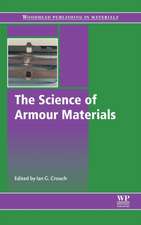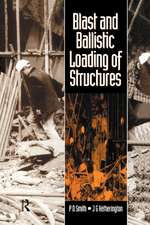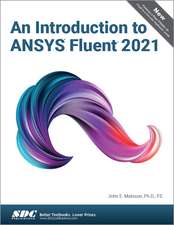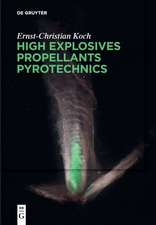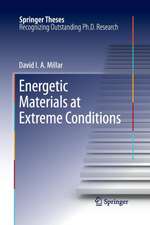Ballistics
Autor Donald E. Carlucci, Sidney S. Jacobsonen Limba Engleză Hardback – 7 mai 2025
Preț: 1183.64 lei
Preț vechi: 1537.20 lei
-23% Nou
Puncte Express: 1775
Preț estimativ în valută:
226.50€ • 242.20$ • 188.84£
226.50€ • 242.20$ • 188.84£
Carte nepublicată încă
Doresc să fiu notificat când acest titlu va fi disponibil:
Se trimite...
Preluare comenzi: 021 569.72.76
Specificații
ISBN-13: 9781032909455
ISBN-10: 1032909455
Pagini: 584
Dimensiuni: 178 x 254 mm
Ediția:4. Auflage
Editura: Taylor & Francis Ltd.
ISBN-10: 1032909455
Pagini: 584
Dimensiuni: 178 x 254 mm
Ediția:4. Auflage
Editura: Taylor & Francis Ltd.
Cuprins
Preface to the Third Edition
Preface to the Second Edition
Preface to the First Edition
Authors
Section I Interior Ballistics
1. Introductory Concepts
2. Physical Foundation of Interior Ballistics
3. Analytic and Computational Ballistics
4. Ammunition Design Practice
5. Weapon Design Practice
6. Recoil Arresting and Recoilless Guns
Section II Exterior Ballistics
7. Introductory Concepts
8. Dynamics Review
9. Trajectories
10. Linearized Aeroballistics
11. Mass Asymmetries
12. Lateral Throwoff
13. Swerve Motion
14. Nonlinear Aeroballistics
Section III Terminal Ballistics
15. Introductory Concepts
16. Penetration Theories
17. Penetration of Homogeneous, Ductile Chromium–Nickel Steel Naval Armor by Three Representative Designs of Nondeforming Hardened Steel Armor-Piercing Projectiles with Bare Noses
18. Shock Physics
19. Introduction to Explosive Effects
20. Shaped Charges
21. Wound Ballistics
Appendix A
Appendix B
Index
Preface to the Second Edition
Preface to the First Edition
Authors
Section I Interior Ballistics
1. Introductory Concepts
2. Physical Foundation of Interior Ballistics
3. Analytic and Computational Ballistics
4. Ammunition Design Practice
5. Weapon Design Practice
6. Recoil Arresting and Recoilless Guns
Section II Exterior Ballistics
7. Introductory Concepts
8. Dynamics Review
9. Trajectories
10. Linearized Aeroballistics
11. Mass Asymmetries
12. Lateral Throwoff
13. Swerve Motion
14. Nonlinear Aeroballistics
Section III Terminal Ballistics
15. Introductory Concepts
16. Penetration Theories
17. Penetration of Homogeneous, Ductile Chromium–Nickel Steel Naval Armor by Three Representative Designs of Nondeforming Hardened Steel Armor-Piercing Projectiles with Bare Noses
18. Shock Physics
19. Introduction to Explosive Effects
20. Shaped Charges
21. Wound Ballistics
Appendix A
Appendix B
Index
Notă biografică
Donald E. Carlucci has been an engineer at the U.S. Army Armament, Research, Development and Engineering Center, Picatinny Arsenal, since May 1989. He is currently the U.S. Army senior scientist for computational structural modeling based at Picatinny. He holds a doctor of philosophy in mechanical engineering (2002) and a master of engineering (mechanical) (1995) degree from the Stevens Institute of Technology, Hoboken, New Jersey. In 1987, he received his bachelor of science degree in mechanical engineering from the New Jersey Institute of Technology, Newark, New Jersey. Dr. Carlucci is an adjunct professor of Mechanical Engineering at the Stevens Institute of Technology.
Sidney S. Jacobson worked as a researcher, designer, and developer of ammunition and weapons at the U.S. Army’s Picatinny Arsenal in New Jersey for 35 years. He rose from junior engineer to associate director for R&D at the arsenal. In 1972, he was awarded an Arsenal Educational Fellowship to study continuum mechanics at Princeton University where he received his second MS degree (1974). He earned a master of science in applied mechanics from Stevens Institute of Technology (1958) and a bachelor of arts in mathematics from Brooklyn College (1951). He retired in 1986 but maintains his interest in the field through teaching, writing, consulting, and lecturing.
Sidney S. Jacobson worked as a researcher, designer, and developer of ammunition and weapons at the U.S. Army’s Picatinny Arsenal in New Jersey for 35 years. He rose from junior engineer to associate director for R&D at the arsenal. In 1972, he was awarded an Arsenal Educational Fellowship to study continuum mechanics at Princeton University where he received his second MS degree (1974). He earned a master of science in applied mechanics from Stevens Institute of Technology (1958) and a bachelor of arts in mathematics from Brooklyn College (1951). He retired in 1986 but maintains his interest in the field through teaching, writing, consulting, and lecturing.


